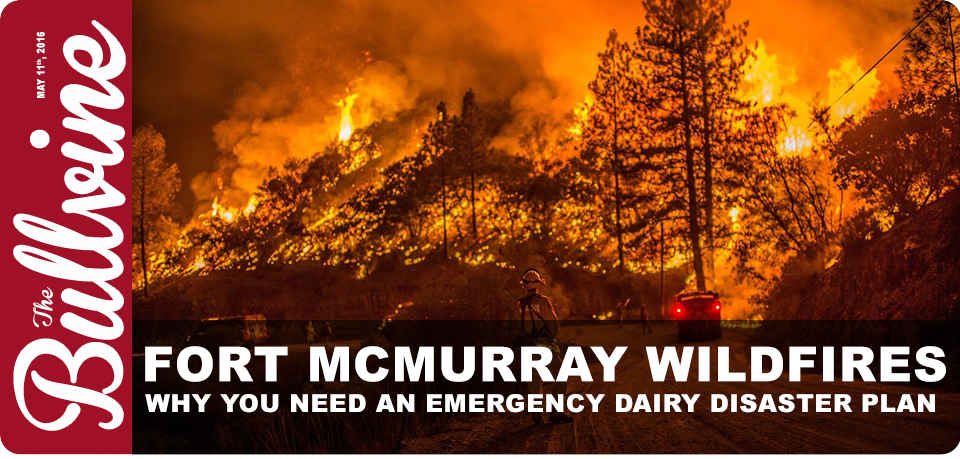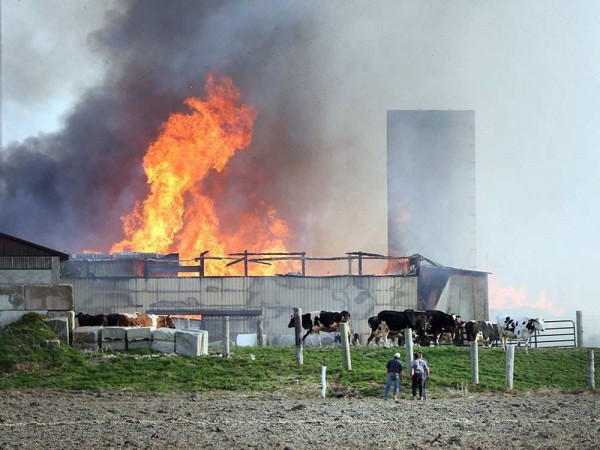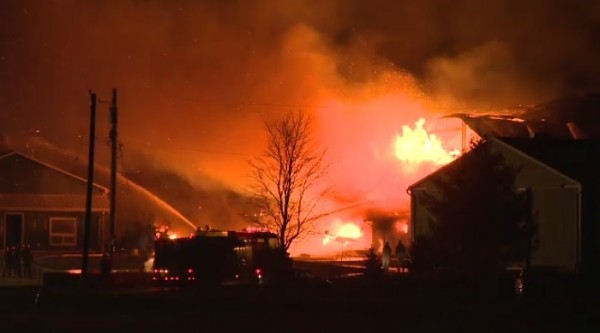The majority of us have never experienced anything even remotely similar to the devastating wildfires that have affected the Fort McMurray, Alberta region. It is mind boggling to consider what the evacuees are going through.
As of May 5, the Alberta government reported that the fire covered an area of approximately 85,000 hectares. This is significant; the consumed area is now half as many hectares as were destroyed in the entirety of both 2008 and 2013.
If your dairy farm was to be put under a mandatory people evacuation order, would you have any idea what needs to happen?
BE READY
Of course, emergencies and disasters by their very nature can occur at any time and without warning. You might think that there is absolutely nothing you can do …. but that would be incorrect. The more you are prepared for potential disaster, the better you will be able to act, minimizing panic and confusion when an emergency occurs.
THINK BEYOND PEOPLE ONLY ON LIVESTOCK FARMS
Relatively speaking farms have more to lose than other companies when a disaster – natural or otherwise — strikes because of the combination of an imminent threat to animals as well as people.
PRIORITIES IN EMERGENCIES
It could be that you have plans in place for evacuating workers from all structures on your dairy farm. But are those plans and the materials needed up-to-date?
It is good planning to have all building exits clearly marked. DC emergency lighting marking exits is a good idea.
The first step is to call 911. However, in disasters the size of Fort McMurray, the emergency lines may be down or overloaded. In any case, make sure that the address of your dairy location is clearly marked at the entrances and that all staff knows the address. It seems simple, but it is one of those things that can be difficult or impossible to remember under stress.
In the case of a barn fire or dairy property-specific event, the first priority is to ensure that no person is harmed. Evacuation of people who could be injured and care for those injured have the highest priority. Always take actions to prevent the involvement of additional people in the event. This means isolating all affected areas from inadvertent involvement by keeping the curious away.
During an emergency, evacuation routes from barns, buildings, and sites must stay clear.
EMERGENCY DAIRY DISASTER PLANNING
Any contingency planning must consider the potential for injuries to people. First aid staff and evacuation teams, rescue equipment and vehicles should be part of any emergency dairy evacuation plan.
Before you go any further, ask yourself these five basic questions:
- How well is your dairy prepared right now, if disaster should strike?
- What procedures do you already have in place for an emergency situation?
- What potential emergency situations could occur?
- If necessary, how will staff return to the disaster zone, if it’s allowed, to attend to animals?
- Who is the leader in times of disaster including when the owner or manager is absent?
ANIMAL EVACUATION DURING A DISASTER
- Put a plan in place for quickly evacuating occupants and animals. It is preferable to prepare to move at least 72 hours ahead of landfall (in the event of hurricanes). Procrastination could be especially problematic. Once the emergency hits, roads may become restricted or even impassable.
- Have enough transportation available and plan for where the animals will be taken.
- Be sure to have access to portable loading ramps to load, or unload animals.
- If your Plan A destination also requires evacuation, it is a good idea to have a Plan B already in place.
- Of course, during this time period, additional biosecurity measures will need to be in place.
- During the disaster event, animals will continue to require feed and water both during transportation and at the destination they are to be taken to.
- It is unfortunate but quite likely that the measures taken will have to remain in place for an extended period of time. Does your plan allow for long-term housing?
- If safe, accessible, locations are a problem, it is a good idea to establish an emergency plan with locations such as fairgrounds, racetracks or exhibition centers.
- Accommodation will need to include milking equipment for lactating cows.
- Milk will need to be stored separately from the cows of other herds. Milk “pickup” companies should be notified where to pick up the milk.
ANIMAL HEALTH DURING A DISASTER
- Ensure that there will be enough feed supplements and sufficient medication supplies available at the destination.
- Minimize the contact among animals from different premises.
- Verify the health and vaccination status of animals which must be co-mingled.
- Handle mortalities in a manner which will minimize the possible spread of contagious disease.
- Monitor the health and well-being of the animals on at least a daily basis, whether sheltered in place or evacuated.
- Seek appropriate veterinary medical advice and services where there is suspicion of an animal disease problem.
- Whether you evacuate or shelter in place, make sure you have adequate and safe ways to separate and group animals appropriately.
- Have specific actions in place to be carried out by assigned people. Assign responsibility for checking all areas to ensure that o person or animal is overlooked.
- Specific actions should include people to close doors, shut off power or fuel sources or to shut down computers and equipment.
- Be particularly aware of the possibility of contaminants or toxins getting into the feed or the animals.
THE LOGISTICS of ANIMAL EVACUATION
- How do animals get out of their containment areas?
- What needs to happen for the animals to be physically evacuated?
- Once removed from the structure or area under threat, where will the animals be moved to?
- Do you have a plan in place (with neighbors or friends?) if the animals require off-property housing and transportation?
- Do you have accurate records of current inventory of animals? Where is it kept and is it easily accessible?
- What needs will your dairy animals have once they have been evacuated?
- How will you address the ongoing needs of your animals throughout the duration of the evacuation order or disaster recovery time period?
- Information is key during an emergency. Current status and ongoing updates must be communicated keeping everyone informed regarding evacuation routes, road conditions, materials and equipment, the location of resources and other elements.
- Decision-makers need access to maps, phone directories and other information regarding supplies and resources.
- Emergency plans need to identify what supplies and equipment will be necessary when an emergency occurs.
- As much as possible run simulation drills with staff
THE BULLVINE BOTTOM LINE:
By developing a dairy disaster plan, you are in a much better position to respond, recover and restore your dairy operation if disaster strikes. Educate all dairy staff about the types of emergencies that may occur. Train them in the proper course of action for emergency situations and, as much as possible, run simulation drills with staff. Make sure they understand the components of your evacuation plan and who will be in charge during an emergency. Being ready for a disaster takes planning and practice. Be prepared.
Get original “Bullvine” content sent straight to your email inbox for free.




















Leave a Reply
You must be logged in to post a comment.